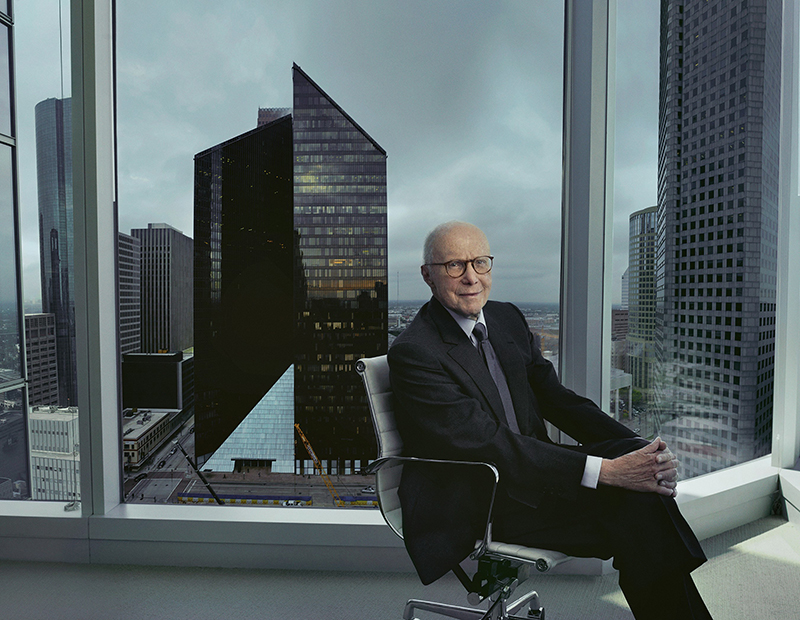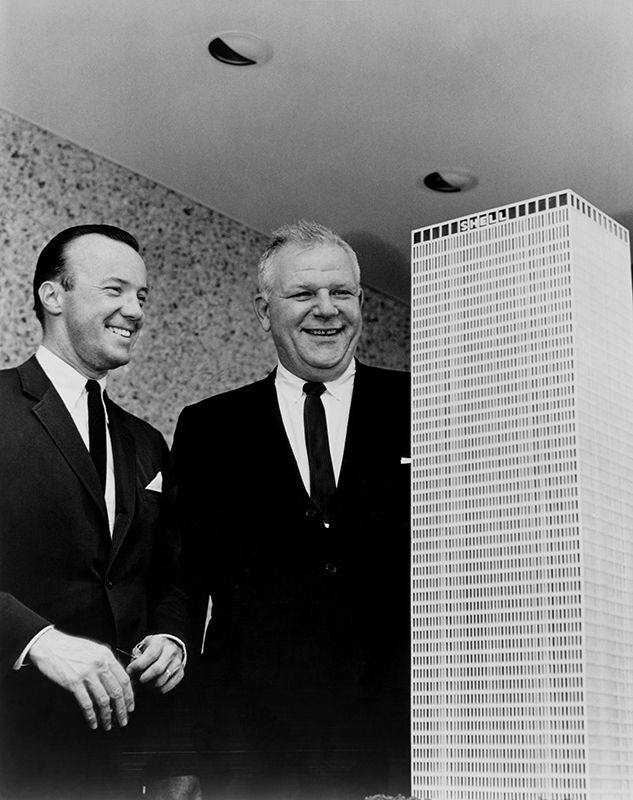The Legacy of Gerald Hines, Master Builder
The founder of Hines built a development giant that changed the industry and shaped skylines around the world.
Gerald D. Hines, the pioneering builder who died Sunday at the age of 95, changed skylines around the world and raised the bar for quality and style in commercial buildings. The founder & chairman of Houston-based Hines leaves behind a legacy that includes some of the most memorable properties in cities from Chicago to Shanghai—out of a portfolio spanning hundreds of projects—and a real estate industry that he helped lead and transform.
Born in Indiana in 1925, Hines established the development firm as a one-man office in Houston in 1957. Over the decades, he built Hines into a diversified global company that is active in 25 countries and 225 cities. His son Jeffrey Hines, who has been running the firm as president since 1990, now assumes the role of chairman & CEO of a company with more than 4,800 employees, $144.1 billion of assets under management and 165 developments underway.
One measure of the firm’s global significance is that the Council on Tall Buildings and Urban Habitat, which tracks the world’s loftiest towers, includes about 150 Hines projects in its database. Many of these properties set new height records in their respective cities, including Salesforce Tower in San Francisco; JP Morgan Chase Tower in Houston; the Devon Energy Center in Oklahoma City; and Italy’s tallest building, the Unicredit Tower in Milan.
A relentless focus on architecture and aesthetics defined these vertical efforts. Through collaborations with eminent designers such as Norman Foster, Frank Gehry, I.M. Pei, Cesar Pelli and Fred Clarke, Hines showed that projects could be both stylish and commercially successful. He also led the way in sustainability, building a firm that now lists nearly 77 million square feet in the U.S. Environmental Protection Agency’s Energy Star program.
“Gerald Hines changed the game in the world of development,” Art Gensler, founder of architecture firm Gensler, noted to Commercial Property Executive in a statement. “Beyond being an early client, we became friends. He transformed how developers and owners could bring people into a new design well before buildings were built. He knew how to reach people at the human level and we knew how to design for them. It was a wonderful partnership and familiar friendship.”
Launching in Houston
Decades before he became one of the industry’s most important figures, Gerald Hines served as a lieutenant in the U.S. Army Corps of Engineers, stationed in Washington, and graduated from Purdue University with a degree in mechanical engineering. He took a job with HVAC equipment manufacturer American Blower Corp, then become a partner of Texas Engineering Co., before starting his own venture.
In the 1960s, the then-relatively inexperienced Hines persuaded Shell Oil to hire him to build a 50-story tower in downtown Houston that would house the energy giant’s new headquarters. The resulting project, One Shell Plaza, was the tallest building in Texas upon completion in 1971 and remains the world’s tallest lightweight concrete structure at 715 feet. Shell’s relocation from New York City to Houston kicked off a furious building boom in the city as other corporations moved in.
The project was a watershed in another sense. As Mark Seal writes in Hines: A Legacy of Quality in the Built Environment, Hines simultaneously guaranteed the construction costs for both Shell Plaza and the Galleria, another 1960s Houston landmark and an early example of the upscale mixed-use retail project. Hines addressed the high-risk situation by bringing in partners, but the episode was a turning point. From then on, Hines took an equity financing approach that departed from the conventional development strategy of making a down payment and financing the rest.
That practice helped earn Hines a reputation for financial probity that led to his appointment as chairman of the Dallas Federal Reserve Bank under Federal Reserve Chairman Paul Volcker from 1981 to 1983.
Global powerhouse
Following a series of successful projects in his Texas home base, Hines expanded nationwide by opening offices in New York, San Francisco, Atlanta, Chicago and other cities. Over the decades his firm developed more than 885 projects, including signature properties such as 53rd at Third, known as the Lipstick Building, in Manhattan; 101 California in San Francisco; Three First National Plaza in Chicago; and One Ninety One Peachtree in Atlanta.
Hines’ company became truly global over the decades, just as its founder, who resided in London for much of his later years, became a man of the world. In the 1990s, for example, the company ventured into China and Russia, where it brought new standards of excellence with projects as One Museum Place, a 60-story prime office tower that opened last year in Shanghai.
Along the way, Hines has collected a plethora of industry awards as well as recognition for its pathbreaking sustainability efforts from organizations such as the U.S. Green Building Council and Global Green USA. Among its sustainable projects is Bayside Toronto, a 13-acre master-planned community along Toronto’s eastern waterfront, which will include a pair of mass-timber office buildings. The company is also praised for its emphasis on high-quality architecture and concern for the surrounding community.
“In the manner of a major corporation, Gerry Hines trained a whole cadre of executives and created a culture that more resembled that of the Fortune 500 corporations he wanted to attract as tenants than the typical real estate enterprise,” architectural critic Paul Goldberger wrote in his introduction to A Legacy of Quality, describing Hines’ key contributions to the industry.
He added: “For me, architecture will be Gerald Hines’ greatest legacy, since few people have done as much as he has to make architecture a truly public, and genuinely popular, art in our time.”










You must be logged in to post a comment.